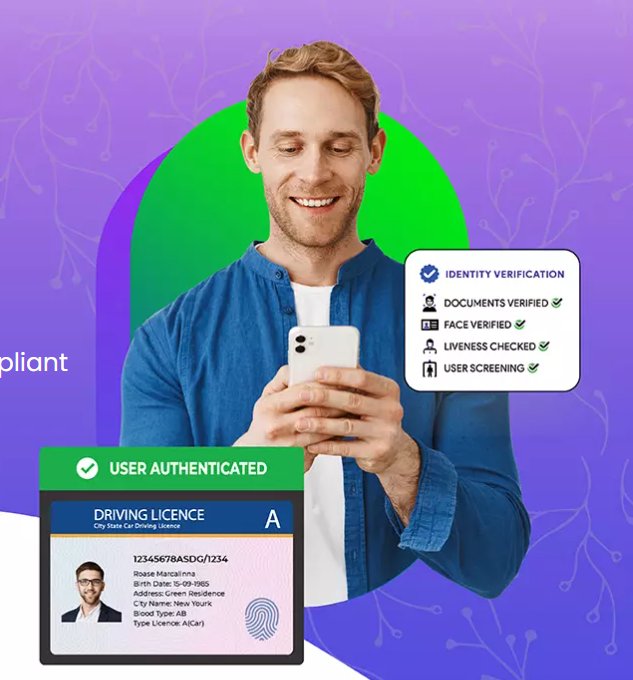Facial Biometric Authentication and Liveness Checks: Enhancing Digital Security
Liveness checks are security measures designed to verify that the user presenting their face is physically present and not using a fake representation.

In today’s digital world, securing personal and corporate data is more critical than ever. Cyber threats are becoming increasingly sophisticated, necessitating advanced security measures. One such innovation is facial biometric authentication, which, when coupled with liveness checks, significantly enhances security in various industries, including banking, healthcare, and e-commerce. This blog explores the significance of facial biometric authentication, its advantages, and the role of liveness checks in preventing fraudulent activities.
What is Facial Biometric Authentication?
Facial biometric authentication is a security process that uses unique facial features to verify an individual’s identity. Unlike traditional password-based authentication, which can be vulnerable to hacking, facial biometrics rely on distinctive patterns such as the shape of the eyes, nose, and jawline to confirm identity. The process leverages artificial intelligence (AI) and machine learning (ML) to analyze and match facial features with stored biometric data, ensuring secure and seamless authentication.
How Facial Biometric Authentication Works
-
Facial Scanning: The user’s face is scanned using a camera, whether on a smartphone, laptop, or biometric kiosk.
-
Feature Extraction: AI algorithms analyze key facial features and convert them into a unique biometric template.
-
Database Comparison: The extracted features are compared with stored biometric data to verify identity.
-
Authentication Outcome: If the scanned facial data matches the stored template, access is granted; otherwise, authentication is denied.
Advantages of Facial Biometric Authentication
1. Enhanced Security
Facial biometric authentication provides a higher level of security compared to traditional methods such as passwords and PINs. Since biometric data is unique to each individual, the chances of unauthorized access are significantly reduced.
2. Convenience and Speed
Users no longer need to remember complex passwords or carry authentication tokens. Facial recognition provides instant access with just a quick scan, enhancing user experience.
3. Reduced Fraud and Identity Theft
Traditional authentication methods are susceptible to phishing, social engineering, and brute-force attacks. Facial biometric authentication eliminates these risks by ensuring that only authorized individuals can access sensitive information.
4. Contactless Authentication
In a post-pandemic world, reducing physical contact is essential for hygiene and safety. Facial recognition provides a touchless authentication method, making it ideal for airports, healthcare institutions, and public spaces.
Understanding Liveness Checks
While facial biometric authentication is highly secure, it is not immune to sophisticated fraud techniques such as spoofing attacks. Fraudsters may attempt to deceive biometric systems using photos, videos, or even 3D masks. This is where liveness checks play a crucial role in ensuring the authenticity of a live user.
What Are Liveness Checks?
Liveness checks are security measures designed to verify that the user presenting their face is physically present and not using a fake representation. AI-powered liveness detection analyzes various indicators to differentiate between real users and fraudulent attempts.
Types of Liveness Checks
-
Active Liveness Detection: The system prompts the user to perform specific actions, such as blinking, smiling, or turning their head. These movements confirm that a real person is present.
-
Passive Liveness Detection: This method operates without requiring user interaction. It detects subtle facial details, such as skin texture, micro-movements, and depth, to confirm authenticity.
-
3D Depth Sensing: Advanced biometric systems use infrared sensors or 3D cameras to detect depth and prevent spoofing attacks using 2D images or videos.
The Importance of Liveness Checks in Security
1. Preventing Spoofing Attacks
Cybercriminals attempt to bypass biometric security using static images, deepfake videos, or masks. Liveness checks mitigate these risks by ensuring that only real, live users can authenticate.
2. Enhancing User Trust
Organizations that implement liveness detection enhance customer confidence in their security measures. Users are assured that their data is protected against impersonation attempts.
3. Regulatory Compliance
Industries such as finance and healthcare must comply with strict security regulations. Implementing liveness checks ensures adherence to regulatory standards like GDPR, KYC, and AML compliance.
Industries Leveraging Facial Biometric Authentication and Liveness Checks
1. Banking and Finance
Banks use facial biometric authentication for secure mobile banking logins, ATM transactions, and KYC verification. Liveness detection prevents fraudsters from using stolen identities to open fraudulent accounts.
2. Healthcare
Hospitals and telemedicine platforms use facial biometrics to verify patient identities and ensure secure access to medical records. Liveness checks prevent unauthorized access to sensitive health information.
3. E-Commerce and Retail
Online retailers use facial authentication to prevent unauthorized account access and fraudulent transactions. Customers benefit from quick and secure checkout processes.
4. Government and Law Enforcement
Governments implement biometric authentication in border security, voter registration, and national ID programs. Liveness checks ensure that only genuine individuals can access services.
Challenges and Future of Facial Biometric Authentication
Despite its advantages, facial biometric authentication faces certain challenges, such as privacy concerns and ethical considerations. Users may be apprehensive about their biometric data being misused. To address this, organizations must adopt robust data encryption measures and ensure transparency in data collection and usage.
Future Innovations
-
AI-Driven Accuracy: Continued advancements in AI and deep learning will enhance facial recognition accuracy and reduce false positives.
-
Blockchain Integration: Combining facial biometrics with blockchain technology can provide tamper-proof identity verification.
-
Cross-Platform Authentication: Future innovations will enable seamless authentication across multiple devices and platforms.
Conclusion
Facial biometric authentication, combined with liveness checks, is revolutionizing digital security by providing a highly secure and user-friendly authentication method. As cyber threats evolve, businesses and organizations must adopt these technologies to safeguard sensitive data and prevent identity fraud. With continuous advancements in AI and biometric security, facial recognition will play an even greater role in ensuring secure digital interactions in the future.
What's Your Reaction?



















.jpg)